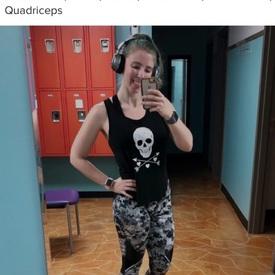sodium

alisonmarytuck
Posts: 68 Member
Can anyone explain to me what the sodium column is telling me in my food diary. I don't understand what the figure means! Thanks
0
Replies
-
Sodium is the primary component of the salt that is in your food. It makes up about 38% of the weight of all the salt. As you're probably aware, you should regulate how much salt to eat as, although your body needs salt to live, too much is bad for you. So keeping your Sodium intake under the recommended level is a good idea. If the food you buy has a Nutrition label on it, you will find either Salt or Sodium listed on it.0
-
It's the amount of salt in your food. The more salt you eat, the more likely you are to retain water. It is pretty hard to avoid if you eat out a lot or buy a lot of canned/boxed foods.
"Some people's bodies are more sensitive to the effects of sodium than are others. If you're sodium sensitive, you retain sodium more easily, leading to fluid retention and increased blood pressure. If this becomes chronic, it can lead to heart disease, stroke, kidney disease and congestive heart failure."
"The Dietary Guidelines for Americans recommend limiting sodium to less than 2,300 mg a day — or 1,500 mg if you're age 51 or older, or if you are black, or if you have high blood pressure, diabetes or chronic kidney disease."
you can read more here:
http://www.mayoclinic.org/healthy-living/nutrition-and-healthy-eating/in-depth/sodium/art-200454790 -
Thanks. Having the American mg guidelines helps as I wsnt really sure what the very high figures meant. In the uk we tend to be told not to eat more than 6 (I think) teaspoons! Actually that has cheered me up as overall my salt count cones well below that American figure0
-
Can anyone explain to me what the sodium column is telling me in my food diary. I don't understand what the figure means! Thanks
As others have said, the sodium column is the amount of sodium in your food. Fruits and vegetables have a natural sodium content. You add sodium when you sprinkle table salt on your food or as an ingredient in cooking. In packaged foods, sodium is often listed under other names than salt so be aware of this hidden sodium. Sodium is important in your body but excess sodium can cause problems. The maximum daily recommendation for sodium from Health Canada is 2,500 mg but Hypertension Canada recommends no more than 2,000 mg per day. A low sodium diet would be 1,200 to 1,300 mg per day which is the amount of sodium in a fast food burger and fries.
Sodium causes water retention so when you are on a weight loss program a high sodium diet or even a day of high sodium eating can mask weight loss. For example, I normally eat low sodium but on Saturday had salted popcorn when we were out which caused me to gain a good pound in retained water. It takes about 2 days to lose this type of water retention.
Talk to your doctor to find out if you are at risk for hypertension. He or she will give you the guidelines you should follow for your sodium intake. Try to stay below those guidelines. In general, the foods that have the highest sodium content are highly processed foods and fast food. While both these types of foods can be enjoyed while dieting if you choose, they may be problematic if you need to restrict your sodium intake.0 -
Just a note to say that, MFP is really not a reliable way to track your sodium intake; unless you are going to check / correct the sodium value for every food you eat.
9/10 the sodium value entered for foods in the MFP is completely wrong - either entered incorrectly as grams of salt, converted from salt to sodium incorrectly, or sometimes (seemingly) made up altogether.
Also, the UK guideline for salt intake is 6g of salt a day - which is ~1 teaspoon, NOT six teaspoons (hence the equivalent to that guideline for sodium is 2363mg).
Units are REALLY important - I think people often get confused between grams and milligrams.
If you are interested in tracking your sodium intake, Google 'Ox Salt' - the first result is a really handy website with lots of easy converters which take the guessing out of it all.0 -
Completely second what Trooty said above, sodium values on the MFP database are appallingly inaccurate, and I do check, and subsequently have to correct, nearly every single entry I come across. Salt grams divided by 2.5 gives sodium, but sodium on the MFP database is in milligrams not grams, so you must then multiply by 1000 to get milligrams of sodium. Almost every user entry will omit the last step if not the first as well so you end up with a *massive* understimate of your sodium intake. Alternatively, sodium is sometimes listed on packaging, but in grams, so one must then again multiply up to get the correct sodium, no-one ever does.0
-
Completely second what Trooty said above, sodium values on the MFP database are appallingly inaccurate, and I do check, and subsequently have to correct, nearly every single entry I come across. Salt grams divided by 2.5 gives sodium, but sodium on the MFP database is in milligrams not grams, so you must then multiply by 1000 to get milligrams of sodium. Almost every user entry will omit the last step if not the first as well so you end up with a *massive* understimate of your sodium intake. Alternatively, sodium is sometimes listed on packaging, but in grams, so one must then again multiply up to get the correct sodium, no-one ever does.
Agree with the first bit having to correct nearly every entry, but I find most people think Salt = Sodium and find people correctly change to mg but don't divide by 2.5 first this has result in some days showing more sodium intake than in reality if not corrected
As you say:
To convert grams of salt to milligrams of sodium, Divide the salt figure in grams by 2.5 and then multiply by 1,000 to get milligrams.
Grams of salt ÷ 2.5 = grams of sodium X 1,000
Salt is sodium chloride.
Sodium is about 40 per cent of the weight of salt, with chloride the remaining 60 per cent.0 -
Mine, when I hit red, tells me I'll be retaining water for the next couple of days!0
-
I so struggle with sodium. It's much harder to cut than anything else.

I wish to God the food companies would make more low or no sodium food and let people add the salt at home.0 -
All of this: vvvvJust a note to say that, MFP is really not a reliable way to track your sodium intake; unless you are going to check / correct the sodium value for every food you eat.
9/10 the sodium value entered for foods in the MFP is completely wrong - either entered incorrectly as grams of salt, converted from salt to sodium incorrectly, or sometimes (seemingly) made up altogether.
Also, the UK guideline for salt intake is 6g of salt a day - which is ~1 teaspoon, NOT six teaspoons (hence the equivalent to that guideline for sodium is 2363mg).
Units are REALLY important - I think people often get confused between grams and milligrams.
If you are interested in tracking your sodium intake, Google 'Ox Salt' - the first result is a really handy website with lots of easy converters which take the guessing out of it all.Completely second what Trooty said above, sodium values on the MFP database are appallingly inaccurate, and I do check, and subsequently have to correct, nearly every single entry I come across. Salt grams divided by 2.5 gives sodium, but sodium on the MFP database is in milligrams not grams, so you must then multiply by 1000 to get milligrams of sodium. Almost every user entry will omit the last step if not the first as well so you end up with a *massive* understimate of your sodium intake. Alternatively, sodium is sometimes listed on packaging, but in grams, so one must then again multiply up to get the correct sodium, no-one ever does.
Agree with the first bit having to correct nearly every entry, but I find most people think Salt = Sodium and find people correctly change to mg but don't divide by 2.5 first this has result in some days showing more sodium intake than in reality if not corrected
As you say:
To convert grams of salt to milligrams of sodium, Divide the salt figure in grams by 2.5 and then multiply by 1,000 to get milligrams.
Grams of salt ÷ 2.5 = grams of sodium X 1,000
Salt is sodium chloride.
Sodium is about 40 per cent of the weight of salt, with chloride the remaining 60 per cent.0
This discussion has been closed.
Categories
- All Categories
- 1.4M Health, Wellness and Goals
- 398.1K Introduce Yourself
- 44.6K Getting Started
- 261.1K Health and Weight Loss
- 176.4K Food and Nutrition
- 47.7K Recipes
- 233K Fitness and Exercise
- 461 Sleep, Mindfulness and Overall Wellness
- 6.5K Goal: Maintaining Weight
- 8.7K Goal: Gaining Weight and Body Building
- 153.4K Motivation and Support
- 8.4K Challenges
- 1.4K Debate Club
- 96.5K Chit-Chat
- 2.6K Fun and Games
- 4.7K MyFitnessPal Information
- 16 News and Announcements
- 20 MyFitnessPal Academy
- 1.5K Feature Suggestions and Ideas
- 3.1K MyFitnessPal Tech Support Questions








